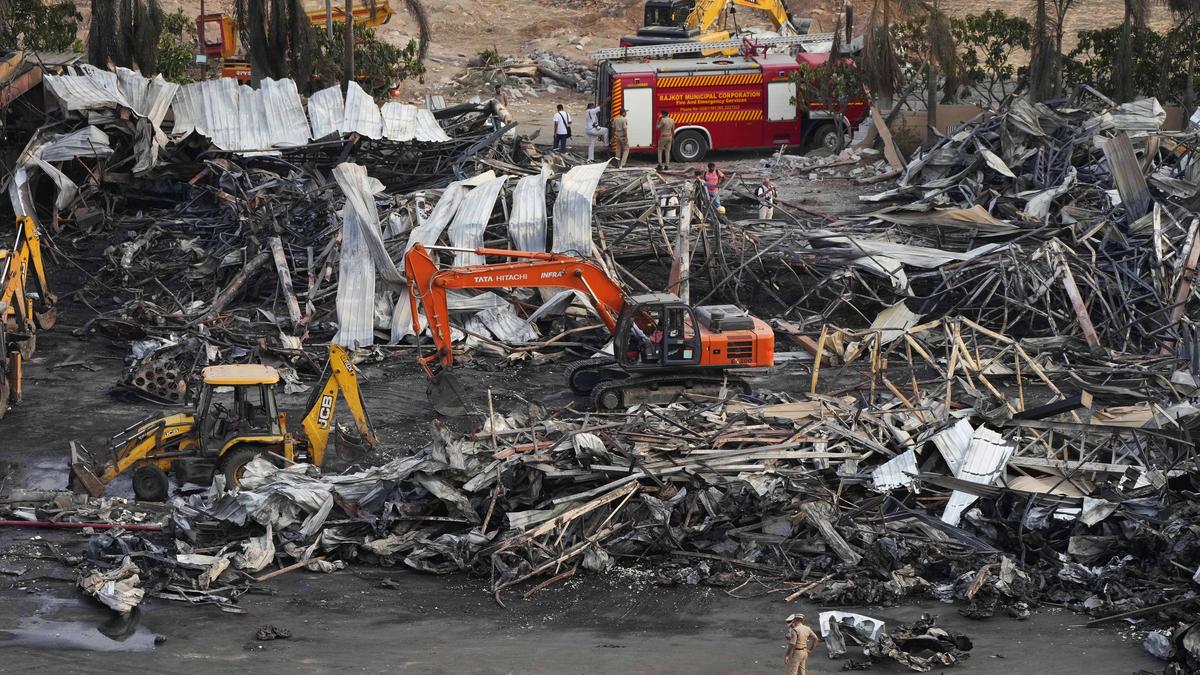
On fire safety regulations in India | Explained
The Hindu
Fire safety regulations in India:Deadly fires in Rajkot and Delhi highlight the urgent need for stricter fire safety regulations in public buildings.
The story so far: A deadly fire at a gaming centre in Rajkot, Gujarat on May 25 killed at least 32 people, bringing focus back on the safety of public buildings and venues. The TRP Game Zone carnage unfolded in the evening, as fire spread inside the structure built with a metal frame and sheets, trapping the victims including several children. Two inquiries have been set up to go into the disaster, one a Special Investigation Team (SIT) by the State government and another by the Rajkot police. The Gujarat High Court suo motu took up the incident and made critical observations on the functioning of the State administration, following which the Police Commissioner, Raju Bhargava, Additional Commissioner Vidhi Choudhary, and Municipal Commissioner Anand Patel were transferred. Rajkot municipal officials including town planning officers responsible for the prevention of illegal constructions were suspended, and four people including the operator of the game zone, Dhaval Thakkar, were arrested.
On May 25, seven babies died in a fire in a hospital for newborns in Vivek Vihar, Delhi, leading to the arrest of Naveen Khichi, owner of the New Born Baby Care Hospital, along with the doctor on duty. Preliminary reports suggested that a large number of oxygen cylinders stored in the facility aggravated the impact of the blaze. In both incidents, the focus is on fire certification by the authorities, issue of No Objection Certificates (NOC), and the failure of authorities to take cognisance of illegalities that were happening in full public view.
The Union of India’s position on fire safety is that the Model Building Bye-Laws, 2016 and its component Chapter 11 on “Fire Protection and Fire Safety Requirements” provides the necessary framework for State governments, which bear responsibility for fire safety under law. Ensuring adherence to fire safety norms and standards laid down in Part 4 of the National Building Code (NBC) and incorporating mandatory provisions in the process is left to the States.
A structure such as the Rajkot game zone would fall under assembly buildings of the bye-laws, since it is a venue without permanent seating arrangements where 300 or more persons would gather. The definition of assembly buildings is broad under the regulations. They include any building or part of a building where “not less than 50 gather for amusement, recreation, social, religious, patriotic, civil, travel and similar purposes, for example, theatres, motion picture houses, assembly halls, museums, skating, rinks, gymnasiums, restaurants, places of worship, dance halls, club rooms, passenger stations and terminals of air, surface and marine public transportation services, recreation piers and stadia.” Hospitals, custodial and penal or mental health institutions are institutional buildings, while educational, business, industry and specialised uses are covered separately.
During the pandemic, amidst a spate of fires, the Health Ministry circulated guidelines on September 28, 2020, stipulating third party accreditation for fire safety and putting a fire response plan in place. Chapter 11 of the Bye-Laws clearly lays down fire safety and infrastructure requirements for buildings which are 49 feet in height or more, and those with low occupancies in various categories, for issue of NOC.
In addition, Gujarat’s Comprehensive Development Control Regulations 2017 also make it mandatory to get the Chief Fire Officer’s opinion even for a temporary structure. The same regulations stipulate that all structures for whatever use must meet fire prevention and safety provisions specified by the Fire Authority, in terms of the Fire Prevention and Life Safety Measures Act, 2013. In the case of the Rajkot game zone, it was built apparently as a non-standard structure to evade regulatory requirements, and the inquiry would reveal whether it was qualified to be used as an assembly building offering leisure and entertainment services.
Among the most high-profile deadly fire accidents that have led to the loss of life, the Uphaar cinema tragedy of 1997 in Delhi resulted in the conviction of the owners of the venue, Sushil Ansal and Gopal Ansal among others for negligence and tampering of evidence. The death of 59 people who were trapped in the balcony of the hall because of illegally installed seats and a blocked exit resulted in a protracted legal battle, with the families of the victims forming an association to seek justice. The Uphaar case was prosecuted with the charge of causing death by negligence (IPC 304A), hurt or grievous hurt by rash or negligent act (337, 338) by the owners of the cinema, and culpable homicide (304) and other sections in the case of theatre staff and public agency employees, such as the electricity authority. A transformer of the electricity authority that was placed without sanction and allowed without safeguards was thought to have triggered the inferno. The owners had to directly bear responsibility for the wilful structural deviations.











